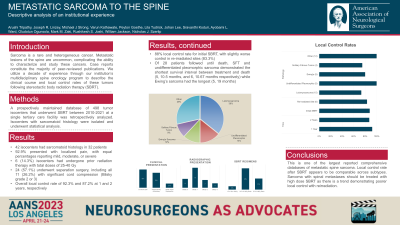Sarcoma of the spine: Descriptive analysis of an institutional experience
Sarcoma of the Spine: Descriptive Analysis of an Institutional Experience
Friday, April 21, 2023


Arushi Tripathy, MD (she/her/hers)
Resident Physician
University of Michigan
Ann Arbor, Michigan, United States
ePoster Presenter(s)
Introduction: Sarcomatous lesions of the spine are uncommon, rendering trend characterization nearly impossible. In fact, in a literature review, the vast majority of peer-reviewed journal articles describing spine sarcomas are case reports. In this experiential study, we review our institution’s encounters with spine sarcomas.
Methods: Numerous data points were compiled for spine tumors diagnosed between 2013 and 2020 at the University of Michigan. Tumors with sarcomatoid histology were isolated from this list and underwent statistical analysis.
Results: 12% (62 of 518) of spine tumors expressed sarcomatoid histology and were diagnosed at a mean age of 59 (range 23-89) years. The most common subtype was leiomyosarcoma (22.6%, n=14) which had a strong female predominance (92.9%, n=13). 17.7% (n=11) were confirmed to be primary spine sarcomas. 77.4% (n=48) presented with no neurological deficit however 90.3% (n=56) had some degree of back pain. All patients were treated with SBRT (average dose approximately 30Gy), and 56.5% (n=35) underwent surgical intervention. 48.4% (n=30) were subsequently found to have systemic progression. Of 34 patients followed until death, primary spine sarcomas and solitary fibrous tumor demonstrated the shortest survival interval between treatment and death (mean 5.4 months, n=5, 8.4 months, n=5, respectively) while Ewing’s sarcoma had the longest (19 months, n=5).
Conclusion : Most patients with spine sarcomas present ambulatory and without neurologic deficit, however do complain of back pain. While the most common subtype (leiomyosarcoma) was primarily found in females, only 48.39% of all spine sarcomas were found in females. Survival among patients with some primary spine sarcomas (chondrosarcoma, solitary fibrous tumor, malignant peripheral nerve sheath tumor, etc.) was poor, however within our frame of follow up, mortality among chordomas was 0%. Long-term collection of institutional databases is required to better understand the behavior and outcomes of spine sarcomas.
Methods: Numerous data points were compiled for spine tumors diagnosed between 2013 and 2020 at the University of Michigan. Tumors with sarcomatoid histology were isolated from this list and underwent statistical analysis.
Results: 12% (62 of 518) of spine tumors expressed sarcomatoid histology and were diagnosed at a mean age of 59 (range 23-89) years. The most common subtype was leiomyosarcoma (22.6%, n=14) which had a strong female predominance (92.9%, n=13). 17.7% (n=11) were confirmed to be primary spine sarcomas. 77.4% (n=48) presented with no neurological deficit however 90.3% (n=56) had some degree of back pain. All patients were treated with SBRT (average dose approximately 30Gy), and 56.5% (n=35) underwent surgical intervention. 48.4% (n=30) were subsequently found to have systemic progression. Of 34 patients followed until death, primary spine sarcomas and solitary fibrous tumor demonstrated the shortest survival interval between treatment and death (mean 5.4 months, n=5, 8.4 months, n=5, respectively) while Ewing’s sarcoma had the longest (19 months, n=5).
Conclusion : Most patients with spine sarcomas present ambulatory and without neurologic deficit, however do complain of back pain. While the most common subtype (leiomyosarcoma) was primarily found in females, only 48.39% of all spine sarcomas were found in females. Survival among patients with some primary spine sarcomas (chondrosarcoma, solitary fibrous tumor, malignant peripheral nerve sheath tumor, etc.) was poor, however within our frame of follow up, mortality among chordomas was 0%. Long-term collection of institutional databases is required to better understand the behavior and outcomes of spine sarcomas.
